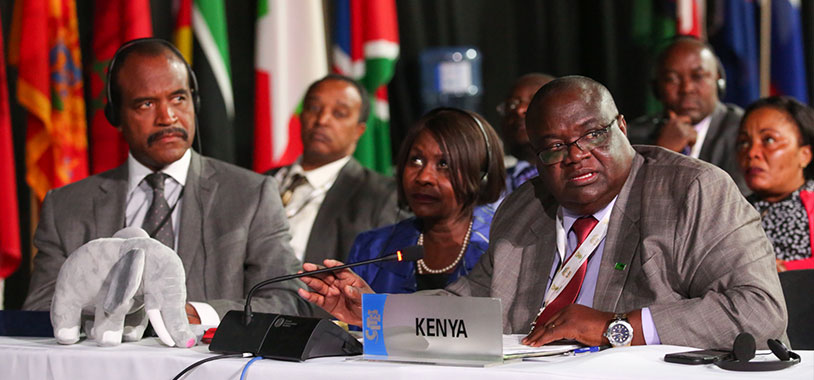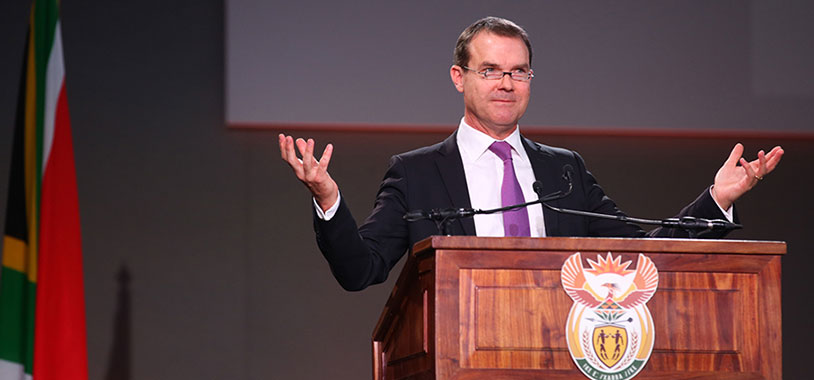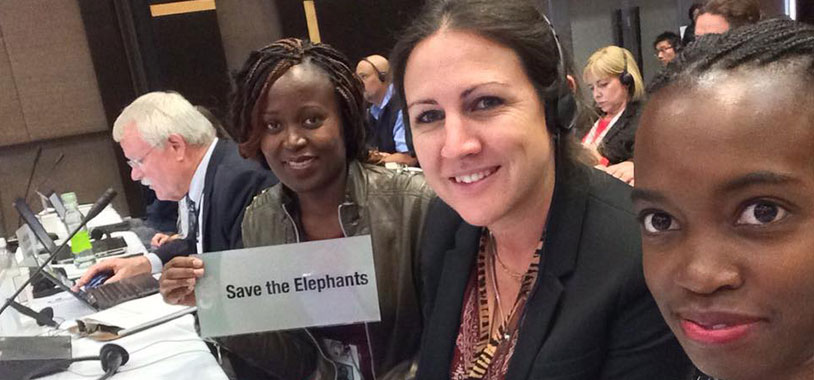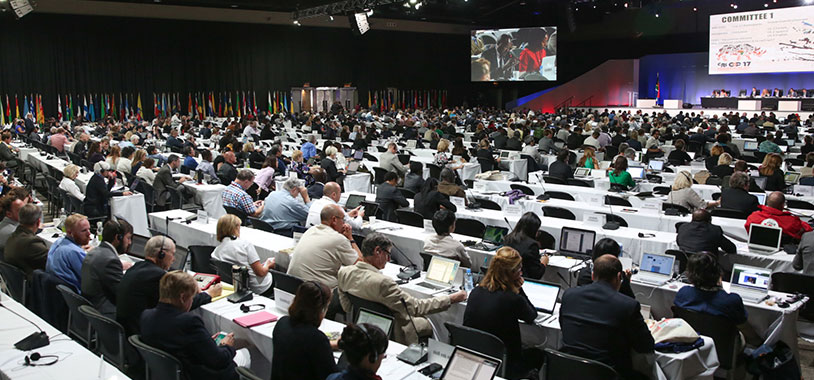Best CITES since 1989?
The Conference of the Parties for the Convention of International Trade in Endangered Species of wild fauna and flora (CITES CoP17) ended in a colourful display of waving flags on the night of Tuesday 4th October.
As seasoned CITES delegates from the Species Survival Network strolled out of the meeting hall, one remarked to another, “this is been the best CITES CoP for elephants since 1989!” He said, referring to the year that the international trade in ivory was banned.
Save the Elephants goes home with the same renewed vigour. With domestic markets now being pressed to close, and no ivory trade mechanisms being discussed between conventions since 2007, there have indeed been big wins for elephants.
During long nights in Working Groups, Save the Elephants joined other NGOs and party delegates in fighting for the discussion on domestic markets to be had. STE also seconded Dr. Ben Okita to the Kenya delegation, where he played a critical role in speaking as a party for the closure of domestic markets.
In one Working Group, where Japan tried to propose that domestic markets were not linked to illegal international markets, Ben insisted that “for as long as not all the ivory in the market place is from legal government stocks, ivory clearly is coming into the country from somewhere. There is strong evidence that not only are the markets linked, but they are driving illegal killing of elephants.”
His argument was quickly backed up by IFAW’s Grace Gabriel who gave the example of the closure of domestic auction markets in China being correlated to decreases in poaching intensity (as measured by the ‘Proportion of Illegally Killed Elephants’, a key metric), documented in a paper published in Conservation Biology by former Save the Elephants intern & innovative researcher Yufang Gao. These points were critical to getting the parties to agree that not only should this subject be discussed, but that domestic ivory markets, linked to illegal killing should be urged to close as a matter of urgency.
STE put its weight behind interventions on putting an end to the discussions on the Decision Making Mechanism (DMM), a system proposed by pro-trade southern African nations nine years ago to facilitate decisions on the sale of ivory in future. The intervention by the Species Survival Network, in support of the African Elephant Coalition proposal to close this discussion, read in part: “The world has moved on since [Decision COP14.77] was adopted in 2007 and there has since been an unprecedented escalation in poaching and illegal ivory trade. The severity of the crisis facing Africa’s elephants is now much better understood.”
“There is a growing recognition of the significant mismatch between the level of demand for ivory (primarily in the Far East) and the amount of ivory that could be supplied by a well-regulated legal supply…We therefore believe that the DMM is no longer relevant, is a waste of scarce resources, and is an unnecessary distraction from the real priorities that should be the focus of CoP17 which are; to secure elephant populations across Africa, combat trafficking, and greatly reduce demand for ivory.”
After three consecutive votes on this matter, the DMM was finally shelved once and for all, giving a breather for elephants for the next three years from the threat of speculators banking on such discussions to fuel more illegal killing and trafficking of ivory.
STE’s Side Event
As a plethora of policy decisions were argued, STE also took time to consider what can be accomplished on the ground in a span of three years, through an update of the Elephant Crisis Fund (ECF). With over 109 projects and 42 grantees, STE’s side event that brought together experts to discuss the novel, collaborative and catalytic steps that are being taken to save Africa’s elephants.
Dr. Iain Douglas-Hamilton and Dr. Chris Thouless explained the value of the tracking app jointly created with Vulcan for anti-poaching operations, and the need to protect not just well known populations but even the last pockets of 200 elephants in Yankari, Nigeria and Ziama, Guinea.
The side event hosted three beneficiary organisations who spoke about their area of work in bringing an end to the crisis. Grace Gabriel, Asia Regional Director for the International Fund for Animal Welfare, introduced her work with opinion leaders from diverse sectors across China that speak to different audiences to stop buying ivory. Charles Tumwesigye, Deputy Director of Uganda Wildlife Authority, thanked the ECF for the much needed support for law enforcement in an area that is becoming an increasingly important entrepot for illegal ivory. Leon Lamprecht, Operations Director for African Parks spoke about the challenges and successes of anti-poaching in heavily hit parks in Africa.
It was also a chance to speak to elephant experts and protected area managers, some of whom are getting jaded with the same approaches, and looking for truly original ways of working. The new tools to assess the age and origin of ivory developed by our colleagues Dr. Sam Wasser and Dr. Thure Cerling (presented at another side event) were discussed in the light of their ability to prove beyond doubt the link between domestic and international trade in ivory. Iain made it clear that whatever the technique, stopping the killing, the trafficking and the demand for ivory would have to remain a priority for all involved.
Appendix I
Of course, the whole conference waited with baited breath for the anti-trade proposal put forward to move all elephant populations onto the Appendix I list that bans any trade in their body parts, and pro-trade counter proposals to lift a bar on those countries whose elephant populations are listed on Appendix II from trading in ivory. The discussions were fiery with strong positions being taken on either side.
The crux of the Southern African contention was the argument that communities could not survive without a consumptive benefit from wildlife, something that we know from our work in Kenya to be far from the truth. Throughout our time at CITES, STE’s exhibition stand was filled with people asking these questions, ably rebutted by Lesley Nalwa who would talk about the success of community conservation without elephants having to die.
A potent tool used in this debate was an illustrated calendar developed by Dr. Lucy King and her Human Elephant Conflict team. The calendar shows twelve low and high tech techniques that communities can use to live in harmony with elephants.
As accusations were thrown on the floor, Resson Kantai Duff helped the Conservation Alliance of Kenya’s Dickson Kaello draft an intervention showing that in fact communities could organise themselves to benefit without consumptive use.
The intervention read in part: “Our community conservation has the committed intention to deal with community concerns first – such as revolutionizing the issue of security, eco-tourism benefits, livestock grazing programs, allowing communities to continue their primary economic activity alongside elephants and other wildlife; microfinance programs for women and youth, and selling of carbon credits in wilderness areas. All these approaches provide benefits and empowerment to the community… We are glad that parties were not persuaded by arguments that without trade in elephant ivory our rural communities will die of hunger or will not have access to development until ivory is traded.”
A short time later, Botswana, home to 35% of Africa’s remaining elephants, shocked the world by weighing in on the debate. “Although Botswana supported the idea of limited, legal ivory sales from countries that managed their elephant herds sustainably, we now recognize that we can no longer support these sales,” Tshekedi Khama, Botswana’s Minister of Environment, Wildlife and Tourism said. “We must unite [in] solidarity with our colleagues regionally and worldwide to stop this crisis.”
Even this powerful statement for unity in saving elephants, the vote still fell short of the two-thirds majority needed for the Appendix I listing to take place. Though it was hoped by many that the EU would turn to give support to this, they stood firm in their position that the listing did not meet the biological criteria. Save the Elephants, being first and foremost a research organisation, respects this position, as well as the widely held understanding that if the uplisting did happen, pro-trade countries would have taken a reservation. This would mean that for these countries would willfully step outside of the convention, and exercise their right to trade. This would have been disastrous for elephants, far more disastrous than how it stands now.
Looking Forward
There have been far more gains than losses for elephants this time round. Though the decision on domestic markets had caveats and compromises, we still find major reasons for hope. African states have seen the power they can possess in deciding the future of their own megafauna, and we do hope for progress as they work towards using the African Union as a platform in finding common ground for wildlife protection. With no further discussion on trade for the foreseeable future, we can all spend our much needed energy on the making a difference on the ground.
As we wait to see the implications of CITES decisions, we continue to work to secure a future for elephants and the spaces where they live so that we can delight in them and the intelligence of their world for generations to come.

L-R KWS Director General Kitili Mbithi, Kenya Cabinet Secretary for Environment Prof. Judi Wakhungu, and KWS Deputy Director Species Conservation and Management, Patrick Omondi at the Conference. @IISD/ENB




